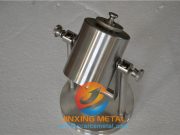Product Description
Tungsten Alloy Vial Shield for Positron emission tomography (PET)
Positron emission tomography (PET) is one of the nuclear medicine techniques available for diagnosis. Whilst X-rays provide information on the structure of the body, PET shows the chemical function of a particular organism. PET involves the injection of FDG (a glucose-based radionuclide) from a shielded syringe into the patient. As the FDG travels through the patient’s body it emits gamma radiation which is detected by a gamma camera, from which the chemical activity within cells and organs can be seen. Any abnormal chemical activity may be a sign that tumours are present. PET scans are frequently used to detect cancerous tumours and diseases of the brain and coronary arteries.
Applications for tungsten alloy shielding in PET include:
PET syringe shield
Tungsten vial shield
Tungsten FDG transport container
Collimator for gamma camera
Technetium generator
Tungsten Alloy Vial Shield for Multi Leaf collimator
Radiotherapy destroys cancer by directing beams of radiation directly onto the tumour. The beams of radiation require a very fine focus to avoid harming the surrounding healthy tissue. This focus is achieved by using a multi-leaf collimator , consisting of two rows of very thin tungsten alloy plates, which can be configured to exactly match the dimensions of the tumour.
Please leave your information to get the latest quotation and product catalogue!





